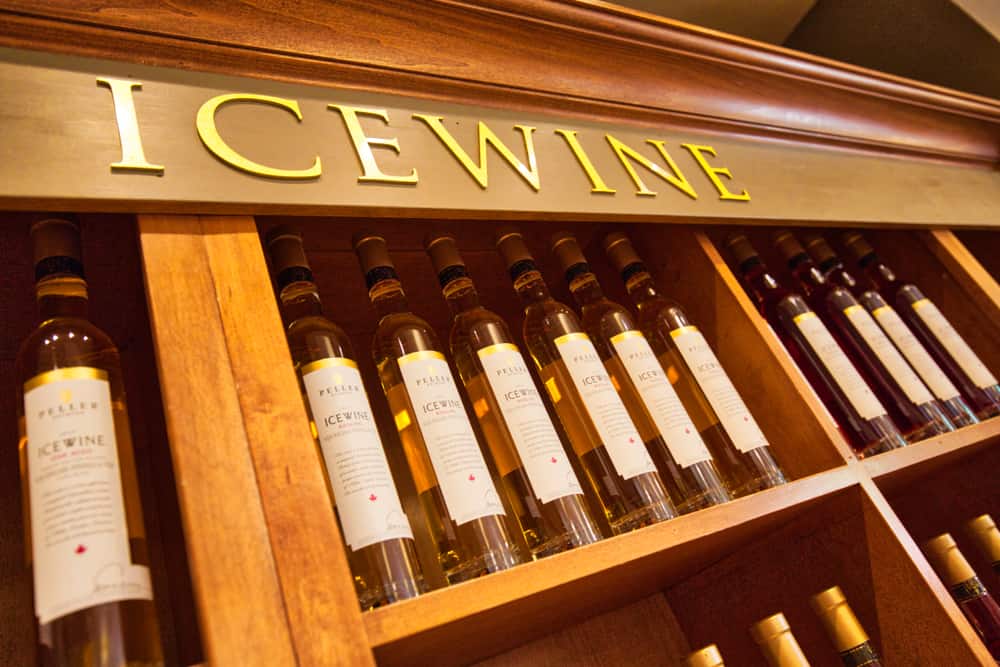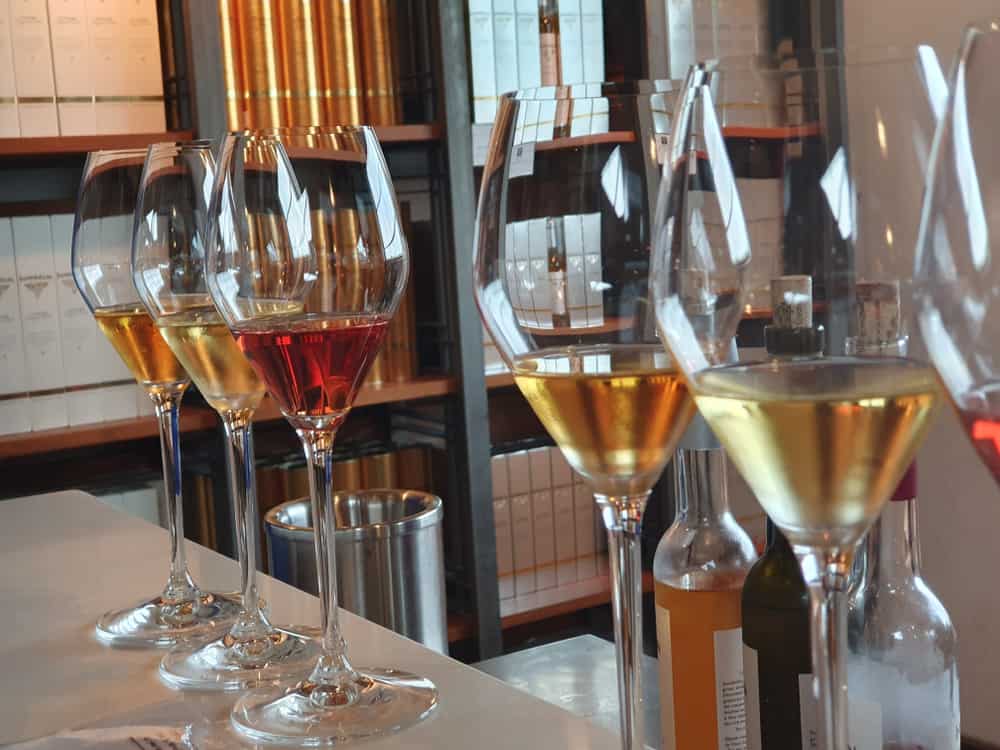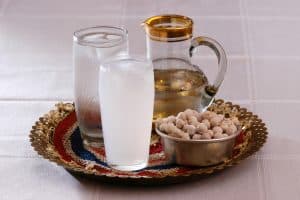
Winemakers know when they work with nature, miracles happen. Leaving grapes on the vines through the late fall and into the freezing winter until they either resemble raisins or frozen marbles produces a concentrated sweetness.
The result is: a dessert wine called ice wine (dubbed Eiswein in Austria and Germany and where the product originated).
Now, you’re thinking, how do you drink ice wine?
Ice wine is served in small quantities, and here, bigger sips give more flavor. Try to avoid the wine touching the tip of your tongue. This allows you to experience the change in taste as you let the wine linger in your mouth and the background flavors come to the fore.
We associate drinking ice wine with dessert because of the concentrated sweetness. However, you can serve it as an apéritif, with the main meal or dessert. One or two ounces per person is enough.
You don’t need special glasses, but our recommendation is stemless wine glasses. Serve it chilled around 54 to 56 degrees Fahrenheit.
Further in the article, we’ll look at ice wine production, recommendations for drinking and enjoying ice wine, and suggest food pairings.
How Is Ice Wine Produced?

Ice wine’s origins can be traced back to Franken, Germany. An early frost in 1794 froze the grapes in the vineyard, and the desperate monks tried to salvage what they could and pressed the frozen grapes.
It rewarded them with ambrosial sweet nectar with an excellent taste produced during the coldest winters.
Making ice wine is a delicate process, and winemakers leave nothing to chance—Mother Nature dictates the schedule, but she also rewards patience.
Grapes are left on the vines during fall going into winter, and as the temperatures dip, over time, this will cause the grapes to lose shape and resemble raisins or look like frozen marbles.
However, a harsh frost too early in the season will ruin the crop. As the temperatures dip, the grapes will sooner or later shrivel, concentrating the juices inside the grapes.
Winemakers harvest grapes when the outside temperature is cool enough to crystalize the water inside the skins, thus concentrating the grapes’ juices.
Canadian law prescribes harvesting grapes may only occur when the temperature dips to 17.6ºF (–8ºC), but some winemakers wait for the mercury to drop even lower; 14 degrees Fahrenheit or –10 degrees Celsius before they start the harvest and treat the grapes.
Producing ice wine cannot start if the conditions aren’t perfect, and with global warming on the rise, ice wine production is tricky these days.
Ice wine production is more expensive to produce due to its weather dependence. Frozen grapes are harvested and pressed using immense hydraulic pressure, and each grape will, at most, produce a single drop of juice, which becomes the fermentation must, leading to ice wine three to six months later.
How To Drink Ice Wine

Drinking ice wine goes against most of the rules associated with conventional wine tasting.
Following the tips set out below, you’ll be able to enjoy this unique wine.
- Avert contact with the tip of your tongue—your other taste receptors will have time to savor the flavors more, leading to a broad taste adventure.
- The bigger the sip, the more you will admire the singular flavors. Don’t be shy, take bigger sips.
- Allow some air into your mouth and swish the ice wine around your mouth, coating your whole palate. Remember to press your tongue against the back of your front teeth to sidestep contact with the sweet receptors on the tip of the tongue.
- Let the sip linger to allow the ice wine’s acids to catch up to your palate. You will experience ‘new’ flavors this way.
- Allow your palate to rest between sips (steps 1–4) and enjoy the experience—don’t rush.
Next, we’ll look at some other tips such as glassware, serving temperature, and food pairings.
Glassware

Some people (read: wine aficionados and sommeliers) regard serving wine as a craft—picking the ‘correct’ glassware associated with the wine, crystal vs. glass, stemless or with a stem, and so forth.
Commonly, ice wine is served in smaller, tulip-shaped glasses—quite similar to a champagne flute.
If you don’t have specialty dessert wine glasses, don’t stress about it—a white wine glass will also do the trick. You also don’t have to take out the apéritif glasses either.
Remember, the ice wine needs to breathe, and you’ll need space to swirl the wine to deliver its bouquets.
Chill the wine glasses for at least 10–15 minutes before serving ice wine.
Serving Temperature

Ice wine is best enjoyed chilled, between 50-54º F (10–12º C).
If it dips below the suggested temperature range, it loses its aromas, and going over ice wine will not be crisp. Look at wine fridges if you feel like taking a walk on the cold side.
You don’t have to buy one specifically for your ice wine, but having the best equipment you can afford makes life a little less complicated.
Proposed Food Combinations

Ice wine is often sweet with intense fruit flavors, making it a perfect match for many foods.
Below are some proposed food combinations to bring out the best in your ice wine.
Desserts
The first rule of drinking ice wine with dessert is to make sure your dessert isn’t sweeter than the ice wine. Fruit-based desserts are great with white wine, while dark chocolate plays finely with red wine.
Cheese
Roquefort, Stilton, or Gorgonzola are distinguished choices, or maybe look at sharp-tasting, hard cheeses such as matured Gruyere or an extra-mature Cheddar.
Their sharp taste will integrate the ice wine’s sweetness.
The French usually serve foie gras and cheeses before a meal, and ice wine compliments these thoroughly too.
Meat & Seafood
Seafood such as lobster, shrimp, and scallops pairs happily with ice wine.
For the more continental palate, we recommend peppery sausages or foods that were pickled, resulting in a salty taste—corned beef slices, Italian salami, Spanish chorizo—form glorious inclusions on a charcuterie platter, and ice wine will complement this too.
World Cuisine
Spicy foodstuffs such as Thai, Mexican, Creole, or Indian are gorgeous options—the sweetness somewhat curbs their burning sensation. Savory or sour Asian dishes are another fine choice.
Conclusion
Ice wine is one of the winter’s exclusive rewards to winemakers—Mother Nature takes part when the conditions are perfect and cold.
Ice wine is sadly seasonal and more pricey to deliver, thus bottled in ‘half’ bottles (375ml or 12.6 oz). It is more expensive, but worth every cent if you can find it.
Ice wine can be presented at any meal stage and is more than a ‘dessert wine,’ making it a versatile wine that pairs with a wide range of strong-tasting and savory foods.









